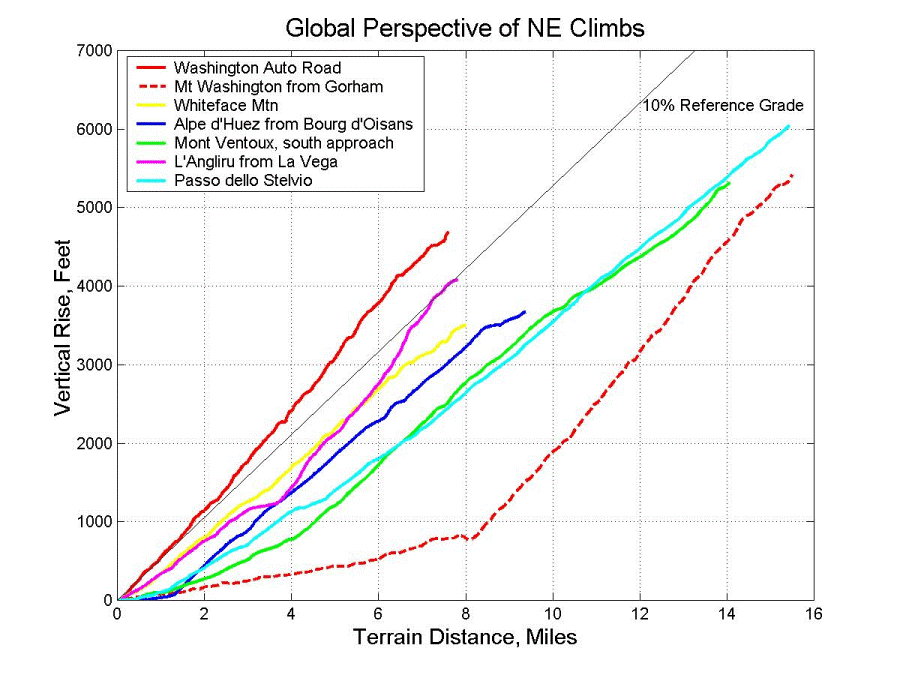Last Update: 25-OCT-05
Comparing Local Climbs with World Famous
Climbs
Ever wonder how Mount Washington
stacks up against Mont Ventoux?
Whiteface with Alpe d’Huez?
This page will give you some insight.
I hunted around on the web to find profiles of a few of the most famous
climbs of the grand tours (I plan to ride these great climbs soon!). The chart below compares Mont Ventoux and
Alpe d’Huez from the Tour de France, Agliru from the Vuelta a Espana, and
Passo dello Stelio from the Giro d’Italia, with New
Hampshire’s Mount Washington and New
York’s Whiteface
Mountain.
As you can see, nothing approaches the steepness of Mt Washington. Angliru comes the closest, with an average
grade of 10%. Agliru has sustained
pitches that are much greater than 10%, so it is a very challenging climb. The image here suggests peak
grade at 23.5%! Whiteface and Alpe
d’Huez are also similar climbs.
Both gain ~3,500 feet in 8 to 9 miles.
Whiteface is slightly steeper, but gains slightly less vertical. Mont Ventoux compares similarly to Mt Washington when starting from the town of Gorham in terms of average
grade. However, Gorham to the auto road
is only a couple percent grade, then the rest of the climb is at 12%. Mont Ventoux stays right around a much more
modest 7% grade. Passo dello Stelvio is
a huge climb, a pass through the mountains, gaining just over 6000 feet in
elevation. Stelvio will be in stage 14
of the 2005 Giro. There are some great
pictures here.
When we local hillclimbers attack Mt Washington, Whiteface, or Equinox, we often
train and peak for that once per season event.
We back off days or even more than a week before the climb to let our
bodies recover. We do the climb, and it
hurts bad, then recover for a couple days afterwards. It is too easy to fall into a trap and say
gee, I just did Whiteface in X hours, which isn’t much slower than some
of the Tour pros did Alpe d’Huez.
There really is no comparison.
Those guys have been going at it for days, 100+ miles per day, at an
unbelievable pace. A stage finish atop a
big mountain might even be the fourth or fifth climb for that stage alone. And, they have to get up the next morning and
do it all over again. A good comparison
might be to do the White Mountains Century on Thursday, finishing at the summit
of Mt Washington
at race pace. Then do it again on
Friday. Then do it again on Saturday,
recording your hillclimb time. You get
the idea. Those guys come from a
different gene pool.

Quantitative Stats on the Climbs
|
Climb
|
Vertical
Rise (ft)
|
Terrain
Distance
(mi)
|
Avg
Grade
(%)
|
Max
Grade
(%)
|
Max
Elevation (ft)
|
Fiets
Difficulty
Index*
|
|
Washington Autoroad
|
4727
|
7.6
|
11.9
|
22
|
6253
|
17.7
|
|
Stelvio
|
6073
|
15.4
|
7.5
|
|
9049
|
15.5
|
|
Angliru
|
4085
|
7.8
|
9.7
|
23.5
|
5151
|
12.9
|
|
Mont Ventoux
|
5650
|
14.1
|
7.2
|
|
6273
|
12.5
|
|
Washington from Gorham
|
5490
|
15.3
|
6.8
|
22
|
6253
|
12.0
|
|
Whiteface
|
3522
|
8.0
|
8.3
|
|
4562
|
9.34
|
|
Alpe
d’Huez
|
3671
|
9.3
|
7.5
|
|
6033
|
9.14
|
* Difficulty index from Dutch cycling magazine
Fiets. It is computed by H^2/(D*10) +
T(>1000m)/1000, where H is height in meters, D is terrain distance in
meters, and T is summit elevation in meters (if above 1000 meters). This metric puts emphasis on steepness of
climbs, and adds additional difficulty for climbs that finish above 1000 meters
(about 3,300 ft) above sea level. For
more info, see fiets or here. My numbers may
differ from other published numbers due to differences in exact starting
location. The Fiets index also does not
take heat, wind, mud, gearing, rider fatigue, etc into account.

